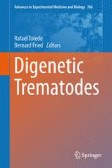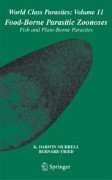Search
Search Results
-
Molecular signatures of the rediae, cercariae and adult stages in the complex life cycles of parasitic flatworms (Digenea: Psilostomatidae)
BackgroundParasitic flatworms (Trematoda: Digenea) represent one of the most remarkable examples of drastic morphological diversity among the stages...

-
Histological description of Cercaria etgesii Shchenkov, 2017 daughter sporocysts (Trematoda: Pleurogenidae): compartmentalization of the brood cavity and germinal mass morphology
Morphology of the daughter sporocysts of Cercaria etgesii Shchenkov, 2017 (Pleurogenidae) has been described according to conventional histological...
-
Echinostomes
Among the species of the Echinostomatidae, total 23 (8 genera) are classified as human-infecting species; Echinostoma revolutum, Echinostoma...
-
New larval trematodes in Biomphalaria species (Planorbidae) from Northeastern Argentina
Larval trematodes infecting Biomphalaria tenagophila and B. occidentalis were surveyed in a suburban and semipermanent pond of Corrientes province,...
-
Larval trematodes in bithyniid snails (Gastropoda: Bithyniidae) in the lake-rivers systems from the steppe zone (The West Siberian Plain, Russia)
A survey of cercariae and metacercariae (Trematoda, Digenea) from bithyniid snails (Gastropoda: Bithyniidae) in lake-river systems in Northern...
-
Form and Function in the Digenea
This review covers form and function in the major organ systems of the Digenea with emphasis on the literature from 1997 to 2012. The literature on...
-
Helminth community structure study on urban and forest blackbird (Turdus merula L.) populations in relation to seasonal bird migration on the south Baltic Sea coast (NW Poland)
The aim of the study was to compare helminth community structure of urban and forest blackbird populations. 24 helminth species in 98 blackbirds were...
-
Can the studies at a spatial scale of 100s meters detect the spatiotemporal fluctuations of a parasite assemblage?
The importance of small-scale heterogeneity in local factors which overrides that of larger-scales factors, suggest that local factors play a major...
-
Descriptions of digenean parasites from three snail species, Bithynia fuchsiana (Morelet), Parafossarulus striatulus Benson and Melanoides tuberculata Müller, in North Vietnam
For first time, 3 species of prosobranchial snails ( Bithynia fuchsiana, Parafossarulus striatulus (Bithyniidae) and Melanoides tuberculata ...
-
Effects of Nonschistosome Larval Trematodes on Biomphalaria Snails
This chapter examines the most salient literature on the development of nonschistosome larval digeneans in Biomphalaria spp. (members of the...
-
Intestinal Flukes
Around the world, 40 to 50 million people are currently estimated to be infected with food-borne intestinal trematodes (Fried et al., 2004),...
-
Larval trematodes in freshwater molluscs from the Elbe to Danube rivers (Southeast Germany): before and today
Studies on life cycles of trematodes have a long tradition in Germany; (Odening
1978 ) listed a total of 177 trematodes, which can potentially... -
The life-history ofMesorchis denticulatus (Rudolphi, 1802) Dietz, 1909 (Trematoda, Echinostomatidae)
Red-tailed gigantocercous cercariae which developed in the euryhaline snail Hydrobia ulvae Pennant (Prosobranchia, Hydrobiidae) in Denmark developed...
-
Psilochasmus aglyptorchis n. sp. (Trematoda, Psilostomidae) und sein Entwicklungszyklus
In one of about 1,000 Laver Spire Shells ( Hydrobia ulvae ) cercariae of the family Psilostomatidae with a dorsal finfold were found. Encystment took...
-
Der Entwicklungszyklus von Psilostomum brevicolle (Creplin, 1829) [Syn.: P. platyurum (Mühling, 1896)] (Trematoda, Psilostomatidae)
The life-cycle of P. brevicolle from Oystercatcher and Herring gull could be traced experimentally. The cercaria from Hydrobia ulvae is of the...
-
Entwicklungs- und Lebensdauer von Metacercarien
The digenetic trematodes can be divided on account of the development of their metacercariae, as far as they show this stage, into three groups: A)...
